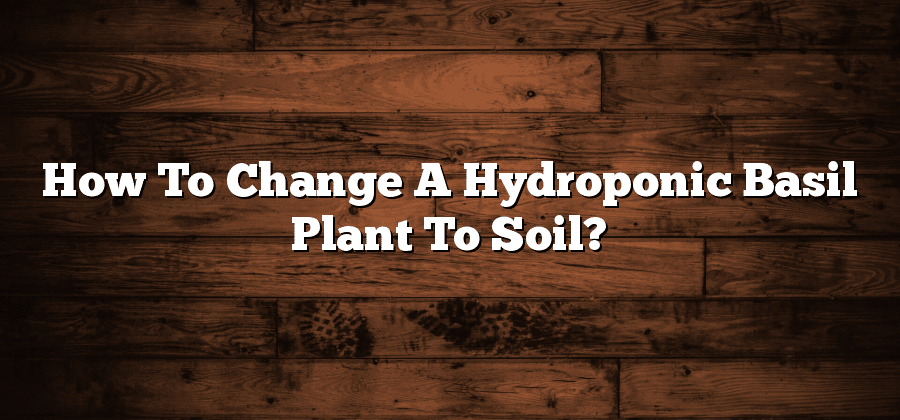Benefits of Transitioning Hydroponic Basil to Soil
Hydroponic basil cultivation has gained popularity over the years due to its numerous advantages. However, there are several benefits to transitioning hydroponic basil to soil that should not be overlooked.
Firstly, transitioning to soil provides a more natural and holistic environment for the basil plant. While hydroponics provide optimal control over nutrient delivery and water levels, soil offers a range of beneficial microorganisms that enhance the plant’s overall health and vigor. These microorganisms, such as beneficial bacteria and fungi, contribute to nutrient cycling and root development, leading to stronger and more resilient plants. Additionally, the introduction of soil can help mimic the plant’s natural habitat, fostering stronger root systems and ultimately improving overall plant performance.
Secondly, growing basil in soil allows for a more sustainable and cost-effective approach. Hydroponic systems require constant monitoring and adjustment to maintain the ideal growing conditions, including precise nutrient solutions and pH levels. In contrast, soil-based cultivation reduces the need for specialized equipment and ongoing monitoring. By relying on the natural fertility of the soil, transitioning to soil cultivation can lead to reduced input costs and a more environmentally friendly approach to basil production. With the rising demand for sustainable farming practices, transitioning hydroponic basil to soil aligns well with the principles of ecological balance and conservation.
Steps to Transition a Hydroponic Basil Plant to Soil
Before transitioning a hydroponic basil plant to soil, there are a few important steps to follow to ensure a successful transfer. Firstly, it is crucial to gradually introduce the basil plant to soil by starting with a mixture of soil and hydroponic growing medium. This will help the plant adjust to the new environment without experiencing shock or stress. Slowly increase the proportion of soil in the mixture over a period of several weeks, allowing the basil plant to adapt to the soil’s different nutrient composition.
Secondly, it is essential to monitor the moisture levels of the soil throughout the transition process. Basil plants prefer slightly moist soil, so it is important to water consistently and avoid overwatering, which can lead to root rot. Regularly check the soil’s moisture by inserting a finger into the soil up to the first knuckle; if it feels dry at this depth, it is time to water the plant. However, if the soil feels wet, it is best to wait for the top inch of soil to dry out before watering again.
By following these crucial steps, you can successfully transition a hydroponic basil plant to soil, providing it with a more natural and nutrient-rich environment.
Selecting the Right Soil for Your Basil Plant
Once you have decided to transition your hydroponic basil plant to soil, selecting the right soil is crucial for its successful growth. The ideal soil for basil should be well-draining, rich in nutrients, and have a slightly acidic to neutral pH level. Sandy loam or loamy soil is commonly recommended for basil as it provides good drainage while retaining enough moisture for the root system. Additionally, the soil should be nutrient-rich to support the plant’s growth and development. Choosing a high-quality potting mix specifically designed for herbs or vegetables can be a reliable option.
When selecting the soil, it is essential to consider the organic content as well. Organic soil contains a higher concentration of nutrients and beneficial microorganisms, which can enhance the overall health of your basil plant. Look for products labeled as organic or enriched with organic matter. These soils tend to have better water retention capabilities and promote root development. Additionally, organic soil supports sustainable gardening practices by reducing the dependence on synthetic fertilizers and contributing to a healthier environment. However, if organic soil is not readily available, a well-balanced commercial potting mix can still provide adequate nutrition for your basil plant.
Preparing the Soil for the Transition Process
To ensure a successful transition from hydroponic to soil cultivation for your basil plant, proper preparation of the soil is crucial. Start by selecting a high-quality soil that is well-draining and rich in nutrients. Look for a soil mix specifically formulated for herbs or vegetables, as these will provide the necessary components for healthy growth.
Before transplanting your basil plant, it is essential to prepare the soil to create a favorable environment for root development. Begin by removing any weeds, rocks, or debris from the planting area. Loosen the soil with a garden fork or tiller to improve its overall structure and allow for better water penetration. Additionally, consider adding organic matter, such as compost or well-rotted manure, to enrich the soil and enhance its nutrient content. By taking the time to properly prepare the soil, you set the stage for a smooth transition for your hydroponic basil plant as it adapts to its new growing medium.
Removing the Basil Plant from the Hydroponic System
To successfully transition a hydroponic basil plant to soil, it is crucial to properly remove the plant from the hydroponic system. This process requires careful attention to avoid damaging the plant’s delicate roots. Begin by gently disconnecting any supply lines or hoses, ensuring that no unnecessary force is applied to the plant. Once detached, carefully lift the basil plant from the hydroponic system, ensuring to support the root system. This step is crucial in preventing any damage or shock to the plant as it transitions to its new environment.
When removing the basil plant, it is important to handle it with care to maintain its overall health and vitality. Gentle handling minimizes any stress that the plant may experience during the transition. Once removed from the hydroponic system, it is advisable to keep the plant’s roots submerged in a water-filled container or moist cloth temporarily. This step allows the plant to retain vital moisture and nutrients until it is ready for transplanting into the soil. Following these careful steps ensures a smooth and successful transition from the hydroponic system to the soil, setting the stage for continued growth and thriving basil plants.






